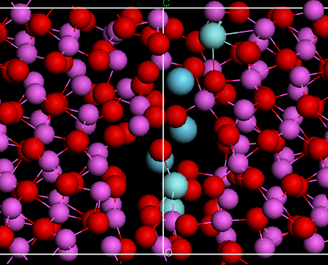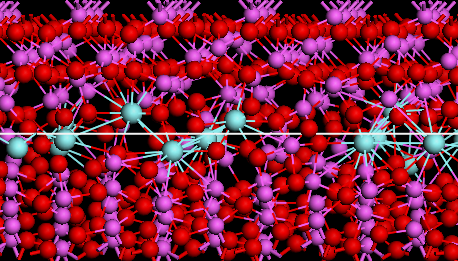Codoping has been seen to give better transparency in PCAs with smaller grain sizes (link to SPS paper processing page experimental observations?). The segregation of Y-La, Y-Mg and La-Mg was simulated using energy minimisation. It was shown that the beneficial effects of codoping over single doping stem from the increased configurational entropy of the segregation due to the higher number of energetically favorable sites available for two dopants [3,4] and both dopants were always predicted to be present at the grain boundaries simulated.
 |
 |
|
| Structure of a simulated (111) mirror twin grain boundary containing both Y (dark blue) and La (light blue) dopants[3]. | Structure of a simulated general near coincidence site lattice grain boundary (01.3/00.1) containing Y dopants[4]. |
A more general near coincidence grain boundary (00.1/01.3) has been simulated after identification by transmission electron microscopy. This helps us approach more realistic situations compared to the computationally convenient, mirror twin boundaries initially investigated. The general grain boundary behaves very differently than the twin grain boundaries Only a fraction of grain boundary cation sites were found to be energetically favorable for the segregation and higher order grain boundary complexions are more probable at the general grain boundaries in comparison to twin grain boundaries [4]. Also high resolution analytical TEM always showed the presence of both Y and La at several grain boundaries as predicted by the atomistic simulations – validating our atomistic scale approach opening the way for knowledge based design of dopants for ceramics via atomistic scale simulations.
|
|
|
| High resolution analytical TEM images and atomistic simulations showing segregation of Y and La with measured concentrations of 415±85 ppm close to the nominal concentration of 450 ppm at the (01.3/00.1) grain boundary [4] (Y-green, La-blue, Al –pink/grey, O- red) |
Publications
[1] Galmarini S., Aschauer U., Bowen P., Parker S.C., Atomistic Simulation of Y-Doped α-Alumina Interfaces, Journal of the American Ceramic Society, 91(11), (2008), 3643-51, (Link to article)
[2] Galmarini S., Aschauer U., Tewari A., Aman Y., Van Gestel C., Bowen P., Atomistic modeling of dopant segregation in α-alumina ceramics: Coverage dependent energy of segregation and nominal dopant solubility. Journal of the European Ceramic Society (2011),31:2839–52 (Link to article)
[3] Tewari A., Galmarini S., Stuer M., Bowen P., Atomistic modeling of the effect of codoping on the atomistic structure of interfaces in α-alumina. Journal of the European Ceramic Society (2012),32:2935–48 (Link to article)
[4] A. Tewari, F. Nabiei, S. C. Parker, M. Cantoni, M. Stuer, P. Bowen, C. Hébert Towards Knowledge Based Grain Boundary Engineering of Transparent Polycrystalline Alumina Combining Advanced TEM and Atomistic Modeling” J. Am. Ceram. Soc., in press (2015) DOI: 10.1111/jace.13552
[5] Aschauer U., Bowen P., Parker S.C., Oxygen vacancy diffusion in alumina: New atomistic simulation methods applied to an old problem, Acta Materialia, 57(16), (2009), 4765-72, (Link to article)
[6] A. Tewari, U. Aschauer, P. Bowen, “Atomistic Modeling of Effect of Mg on Oxygen Vacancy Diffusion in [alpha]-Alumina” J.Amer.Ceram.Soc., 97(8) 2596-2601 (2014)

